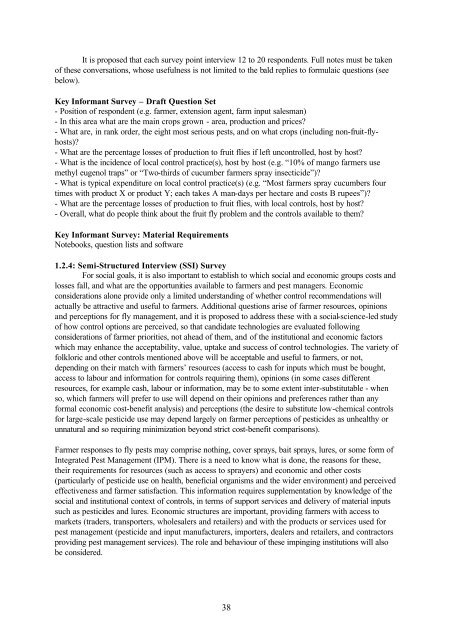“Key Informant Survey” of Production, Value, Losses and ... - DfID
“Key Informant Survey” of Production, Value, Losses and ... - DfID
“Key Informant Survey” of Production, Value, Losses and ... - DfID
Create successful ePaper yourself
Turn your PDF publications into a flip-book with our unique Google optimized e-Paper software.
It is proposed that each survey point interview 12 to 20 respondents. Full notes must be taken<br />
<strong>of</strong> these conversations, whose usefulness is not limited to the bald replies to formulaic questions (see<br />
below).<br />
Key <strong>Informant</strong> Survey – Draft Question Set<br />
- Position <strong>of</strong> respondent (e.g. farmer, extension agent, farm input salesman)<br />
- In this area what are the main crops grown - area, production <strong>and</strong> prices?<br />
- What are, in rank order, the eight most serious pests, <strong>and</strong> on what crops (including non-fruit-flyhosts)?<br />
- What are the percentage losses <strong>of</strong> production to fruit flies if left uncontrolled, host by host?<br />
- What is the incidence <strong>of</strong> local control practice(s), host by host (e.g. “10% <strong>of</strong> mango farmers use<br />
methyl eugenol traps” or “Two-thirds <strong>of</strong> cucumber farmers spray insecticide”)?<br />
- What is typical expenditure on local control practice(s) (e.g. “Most farmers spray cucumbers four<br />
times with product X or product Y; each takes A man-days per hectare <strong>and</strong> costs B rupees”)?<br />
- What are the percentage losses <strong>of</strong> production to fruit flies, with local controls, host by host?<br />
- Overall, what do people think about the fruit fly problem <strong>and</strong> the controls available to them?<br />
Key <strong>Informant</strong> Survey: Material Requirements<br />
Notebooks, question lists <strong>and</strong> s<strong>of</strong>tware<br />
1.2.4: Semi-Structured Interview (SSI) Survey<br />
For social goals, it is also important to establish to which social <strong>and</strong> economic groups costs <strong>and</strong><br />
losses fall, <strong>and</strong> what are the opportunities available to farmers <strong>and</strong> pest managers. Economic<br />
considerations alone provide only a limited underst<strong>and</strong>ing <strong>of</strong> whether control recommendations will<br />
actually be attractive <strong>and</strong> useful to farmers. Additional questions arise <strong>of</strong> farmer resources, opinions<br />
<strong>and</strong> perceptions for fly management, <strong>and</strong> it is proposed to address these with a social-science-led study<br />
<strong>of</strong> how control options are perceived, so that c<strong>and</strong>idate technologies are evaluated following<br />
considerations <strong>of</strong> farmer priorities, not ahead <strong>of</strong> them, <strong>and</strong> <strong>of</strong> the institutional <strong>and</strong> economic factors<br />
which may enhance the acceptability, value, uptake <strong>and</strong> success <strong>of</strong> control technologies. The variety <strong>of</strong><br />
folkloric <strong>and</strong> other controls mentioned above will be acceptable <strong>and</strong> useful to farmers, or not,<br />
depending on their match with farmers’ resources (access to cash for inputs which must be bought,<br />
access to labour <strong>and</strong> information for controls requiring them), opinions (in some cases different<br />
resources, for example cash, labour or information, may be to some extent inter-substitutable - when<br />
so, which farmers will prefer to use will depend on their opinions <strong>and</strong> preferences rather than any<br />
formal economic cost-benefit analysis) <strong>and</strong> perceptions (the desire to substitute low-chemical controls<br />
for large-scale pesticide use may depend largely on farmer perceptions <strong>of</strong> pesticides as unhealthy or<br />
unnatural <strong>and</strong> so requiring minimization beyond strict cost-benefit comparisons).<br />
Farmer responses to fly pests may comprise nothing, cover sprays, bait sprays, lures, or some form <strong>of</strong><br />
Integrated Pest Management (IPM). There is a need to know what is done, the reasons for these,<br />
their requirements for resources (such as access to sprayers) <strong>and</strong> economic <strong>and</strong> other costs<br />
(particularly <strong>of</strong> pesticide use on health, beneficial organisms <strong>and</strong> the wider environment) <strong>and</strong> perceived<br />
effectiveness <strong>and</strong> farmer satisfaction. This information requires supplementation by knowledge <strong>of</strong> the<br />
social <strong>and</strong> institutional context <strong>of</strong> controls, in terms <strong>of</strong> support services <strong>and</strong> delivery <strong>of</strong> material inputs<br />
such as pesticides <strong>and</strong> lures. Economic structures are important, providing farmers with access to<br />
markets (traders, transporters, wholesalers <strong>and</strong> retailers) <strong>and</strong> with the products or services used for<br />
pest management (pesticide <strong>and</strong> input manufacturers, importers, dealers <strong>and</strong> retailers, <strong>and</strong> contractors<br />
providing pest management services). The role <strong>and</strong> behaviour <strong>of</strong> these impinging institutions will also<br />
be considered.<br />
38

















